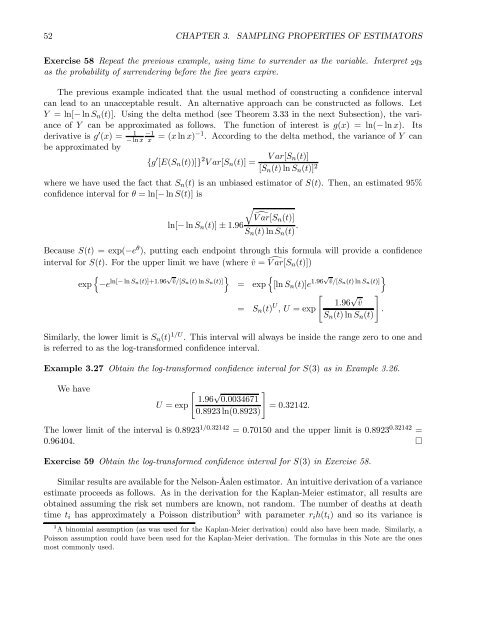Estimation, Evaluation, and Selection of Actuarial Models
Estimation, Evaluation, and Selection of Actuarial Models
Estimation, Evaluation, and Selection of Actuarial Models
Create successful ePaper yourself
Turn your PDF publications into a flip-book with our unique Google optimized e-Paper software.
52 CHAPTER 3. SAMPLING PROPERTIES OF ESTIMATORS<br />
Exercise 58 Repeat the previous example, using time to surrender as the variable. Interpret 2 q 3<br />
as the probability <strong>of</strong> surrendering before the five years expire.<br />
The previous example indicated that the usual method <strong>of</strong> constructing a confidence interval<br />
can lead to an unacceptable result. An alternative approach can be constructed as follows. Let<br />
Y =ln[− ln S n (t)]. Using the delta method (see Theorem 3.33 in the next Subsection), the variance<br />
<strong>of</strong> Y can be approximated as follows. The function <strong>of</strong> interest is g(x) = ln(− ln x). Its<br />
derivative is g 0 (x) = 1<br />
be approximated by<br />
− ln x<br />
−1<br />
x<br />
=(x ln x)−1 . According to the delta method, the variance <strong>of</strong> Y can<br />
{g 0 [E(S n (t))]} 2 Var[S n (t)] = Var[S n(t)]<br />
[S n (t)lnS n (t)] 2<br />
wherewehaveusedthefactthatS n (t) is an unbiased estimator <strong>of</strong> S(t). Then, an estimated 95%<br />
confidence interval for θ =ln[− ln S(t)] is<br />
q<br />
dVar[S n (t)]<br />
ln[− ln S n (t)] ± 1.96<br />
S n (t)lnS n (t) .<br />
Because S(t) =exp(−e θ ), putting each endpoint through this formula will provide a confidence<br />
interval for S(t). Fortheupperlimitwehave(whereˆv = Var[S d n (t)])<br />
n<br />
exp −e ln[− ln S n(t)]+1.96 √ˆv/[S o n (t)lnS n (t)]<br />
= exp<br />
n[ln o<br />
S n (t)]e 1.96√ˆv/[S n (t)lnS n (t)]<br />
"<br />
= S n (t) U 1.96 √ˆv<br />
#<br />
, U =exp<br />
.<br />
S n (t)lnS n (t)<br />
Similarly, the lower limit is S n (t) 1/U . This interval will always be inside the range zero to one <strong>and</strong><br />
is referred to as the log-transformed confidence interval.<br />
Example 3.27 Obtain the log-transformed confidence interval for S(3) as in Example 3.26.<br />
We have<br />
"<br />
1.96 √ #<br />
0.0034671<br />
U =exp<br />
=0.32142.<br />
0.8923 ln(0.8923)<br />
The lower limit <strong>of</strong> the interval is 0.8923 1/0.32142 =0.70150 <strong>and</strong> the upper limit is 0.8923 0.32142 =<br />
0.96404. ¤<br />
Exercise 59 Obtain the log-transformed confidence interval for S(3) in Exercise 58.<br />
Similar results are available for the Nelson-Åalen estimator. An intuitive derivation <strong>of</strong> a variance<br />
estimate proceeds as follows. As in the derivation for the Kaplan-Meier estimator, all results are<br />
obtained assuming the risk set numbers are known, not r<strong>and</strong>om. The number <strong>of</strong> deaths at death<br />
time t i has approximately a Poisson distribution 3 with parameter r i h(t i ) <strong>and</strong> so its variance is<br />
3 A binomial assumption (as was used for the Kaplan-Meier derivation) could also have been made. Similarly, a<br />
Poisson assumption could have been used for the Kaplan-Meier derivation. The formulas in this Note are the ones<br />
most commonly used.
















